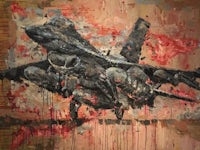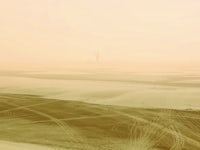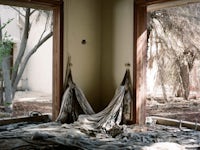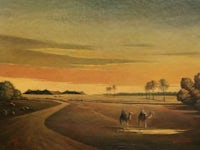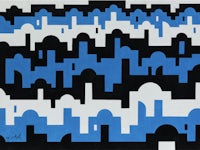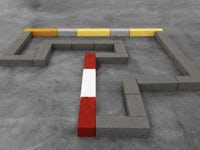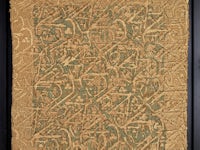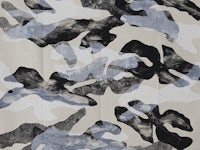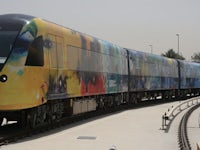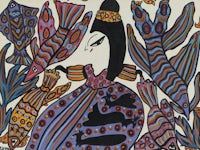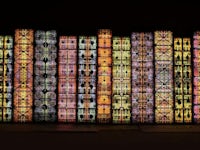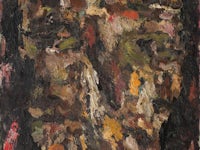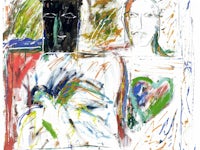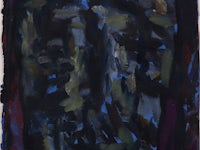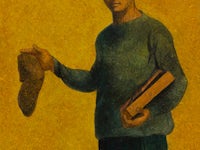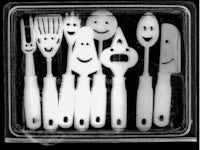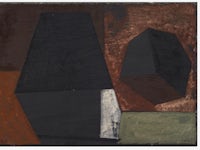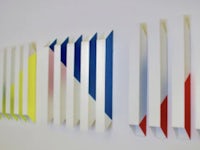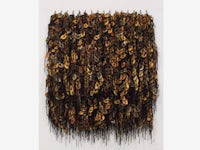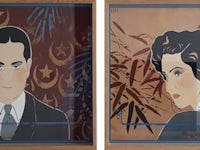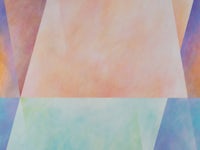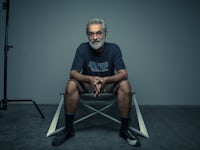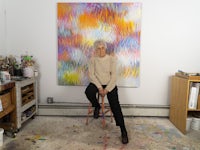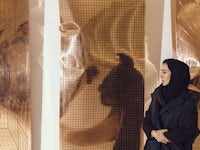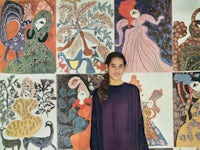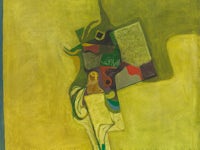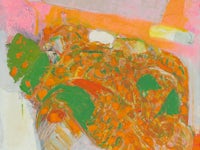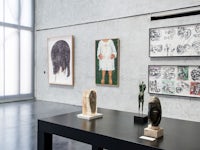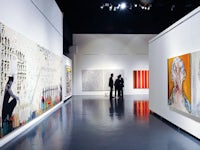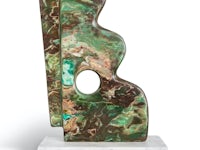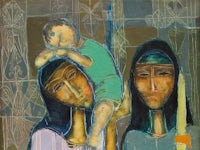The Dubai Collection engages with themes connected with the historical development of the Emirate and the UAE and reflects the values of openness, diversity and interconnectedness as embodied in the spirit of its home. Whilst focusing on the UAE and the region, the Dubai Collection is an international collection with no geographical restrictions, and artworks are selected by a qualified curatorial committee.
Latest Publications
How Do You Paint in Arabic? Exploring the Artistic Oeuvre of Etel Adnan
Encounters: Curator Alia Zaal Lootah on Emirati Artist Connections Across The Ages
Despite its mega-city infrastructure, at the core of Dubai is a village vibe — it is a relatively compact geography where many people know one another or are linked in some way. “Dubai has always been connected to its people and its makers,” says the artist and curator Alia Zaal Lootah. “The early relationship between the rulers and the tradesmen through the ports of Dubai has grown organically over time and created this connection between the people and the government.” This relationship is at the core of the Dubai Collection, a unique initiative that sees local collectors loan their art to create the city’s first institutional collection of modern and contemporary art. “The Dubai Collection creates a collaboration between the state, the collectors, the artists and the public,” Lootah adds. “It’s a beautiful initiative.”
An Interview with Tagreed Darghouth
“We have to share the language that we own with others, and there must be something that the viewer should be highly interested in, because it’s a conversation at the end of the day”.
Expressionism and Engagement. Tagreed Darghouth, Ayman Baalbaki, and the Legacy of Marwan Kassab Bachi
The important Syrian artist Marwan Kassab Bachi (1934 - 2016) moved to Germany in 1957 and spent most of his life in Berlin, studying and then teaching at the Hochschule für Bildende Künste. Unlike many other Arab artists who studied abroad, his work involves a dialogue with the German Expressionist strand of modernism, rather than Cubism derived from Paris, or American forms of Hard-Edge Abstraction.
Memory, Traces & the Passage of Time
Sinuous tire trails cover the foreground of Ali Cherri’s (b. Beirut, 1976) Dust and Other Anxieties (2013). The image, from Abraham Karabajakian’s collection, presents a section of a road. Cherri’s perspective splits the image into three, with marked differences in color and texture. Closest to the viewer is a dark, tire-marked surface. Moving up the image, we notice a flatter, lighter stretch of ground. At the far back, the hazy sky descends onto sandy land; half-hidden by clouds of dust, the fuzzy outline of a monumental statue interrupts the otherwise featureless view.
Density and/or Lightness of Urban Life
Today, over half the world lives in and around a city. By 2045, it will be closer to 70% . As more and more people turn metropolitan, new patterns of urbanity are set to emerge. Creative, dense, contested—cities are alive. They are also hard to decipher, difficult to recuperate within an objective map or explain, minutely, from any singular spot. In this light, the urban artist occupies a special position. She is placed to engage the architectures of our habitations, drawing from the overwhelm of reality and postulating, through aesthetics, the implications of how we live now.
Objects of the Threshold - a liminal reflection
The construct liminal stems from the Latin nouns liminis (or limen) meaning threshold and transire (trans emphasizing the beyond) - to cross over to the other side. Liminality was first used by anthropologists Arnold Van Gennep and later Victor Turner during the 20th century to describe the different stages and the social roles of the rites of passage during rituals (such as marriage or coming-of-age ceremonies). Van Gennep and Turner’s contribution concerning liminality lies in their emphasis on the importance of embracing an in-between, ambiguous, or disorientated state. They argued that these transitional moments are vital for us to move forward as they influence our identity. Contemporary cultural theory, such as Homi Bhabha’s postcolonial perspective in the seminal work The Location of Culture (originally published in 1994), was later greatly influenced by these viewpoints. He defines the liminal as a transitory, mediate “third space of enunciation” that is characterized by uncertainty, hybridity, and potential for cultural change. Cultural liminality is experienced for example when an individual is caught between two cultures after being unsettled or displaced, such as an immigrant experiencing diaspora in a new culture after forcefully having to leave home.
The Desert Picturesque
When considering historical landscape paintings, depicting deserts, palm trees, camels, and large tents in the distance, one might understandably recall images associated with Orientalism. This artistic approach developed from European fascination with cultures and landscapes beyond their own - specifically, those situated to the east of Europe (arguably including northern parts of Africa) - often oversimplified into an imagined collective place known as the Orient. However, Abdulqader Al Rassam’s painting scene from Badia/Baghdad prompts the onlooker to interpret a Middle Eastern landscape that adheres to European landscape painting principles but is neither painted for the European viewer nor portrays the “Orient” as something alien.
Hurufiyya and the Inspiration of Arabic Letters
The term Hurufiyya comes from huruf, the Arabic for ‘letters’, and refers to a form of painting that combines modernist abstraction with Arabic letters or calligraphy. It was coined by the Lebanese poet and critic Charbel Dagher in his book Huroofiya al-Arabiya: Fan Wa Hawiya (1991), translated into English as Arabic Hurufiyya: Art and Identity (2016).[1]
An Interview with Sarah Al Mehairi
“I think you should absolutely go for what you want to go for, explore themes and concepts that are maybe challenging.”
Dubai Calligraphy Biennale
Calligraphy—from the Greek for beautiful writing —is a form that elevates written language into an aesthetic experience. The medium, however, is more than simply pleasing to the eye. Calligraphy is a people’s expression of harmony, being “a statement about the sum total of [their] cultural and historical heritage.” In this spirit, the Dubai Calligraphy Biennale is a platform that gathers various calligraphic lineages. The event contextualizes penmanship as a carrier of history. The multilingual exhibits are an “opportunity for cultural exchange and understanding.”
The Diasporic Filipino Artist - Highlights from Filipino Artists in the Dubai Collection
What does it mean to be an artist in, or of, the Filipino diaspora? To live in the Filipino diaspora is to often be in search of rootedness. It is a constant questioning of your identity and how yours traces back to the motherland (or if it should). It is being in constant nostalgia, a perpetual desire to grasp on to something, anything, that will keep you tethered to where you came from.
Hala Khayat in Conversation with Emirati Artist Abdul Qader Al Rais
Time is not the true measure of a person’s success, but rather the achievements made. This is the case for Dubai based painter Abdul Qader Al Rais, who insists on his continuous support for the art scene in the United Arab Emirates. Today he is in the process of building up a studio space which will be also open to host younger Emirati artists he wishes to mentor. Garnering many regional and international awards over five decades of continuous and relentless work, today Al Rais has become one of the most acclaimed and iconic painters of the United Arab Emirates and a pioneer amongst his peers in creating a true distinct Emirati visual identity. With his unique style inspired by the region’s landscapes and the Arabian Desert architecture, his work is identified by lightness and speed.
For love or money: the art of collecting
“Buy what you love.” This catchphrase is often the first piece of advice given to anyone who suggests they want to purchase a work of art. It is usually followed by the equally confounding “don’t buy art to make money”. But how easy is it to get that right? To truly understand what it means when people say, “it should speak to you”? There’s no set criteria or qualifications to become an art collector or patron of the arts. You don’t need to attain a good degree from a top university or complete a foundation course at an arts college. Strong references or evidence of visiting leading museums around the world are not a prerequisite (although it all helps). It is not imperative to declare your financial status either (although efficient auction houses and galleries will do their research). In many ways, it is the most unfettered and liberating position to be in the art world – and the most essential. This is especially true in a new market such as the scene that has emerged in Dubai during the past two decades.
Painting Nothing: An Introduction to Abstract Art in the Middle East
The traditional Western art history books will tell you that the Russian artist Wassily Kandinsky “invented” abstract art—depiction free from representation, focussing instead on elements of form, colour, line, tone, and texture—in around 1910. As with much of the art history canon, this narrative is slowly being unravelled and lesser-known histories of abstraction are being added to the story, such as the contributions of female artists (for example, the Swedish artist Hilma af Klint painted her first abstract work in 1906) and artistic developments in non-Western regions.
Envisioning a New Collecting Institution in the 21st Century: The Beirut Museum of Art, Lebanon
What should a 21st Century museum look like on the inside? As the newly appointed Co-Directors of the Beirut Museum of Art, Juliana Khalaf and myself have almost a carte-blanche to reinvent what this means – an opportunity that comes once in a lifetime for art world professionals. The museum, which is slated to open in 2026, is the first purpose-built museum of its kind for Lebanon, promising to showcase the treasured art collection of the Lebanese Ministry of Culture (which has never been seen before), in addition to focusing on Modern and Contemporary regional art.
Insight: The Dubai Collection
The best examples of art begin conversations. A balance between commercial and didactic activity has always been a strength of Art Dubai’s programming. This is often the case in an emerging market, without established institutional models, and there is so much that has not yet been said–new voices to listen to, trends, movements, styles and influences to identify. It is why Art Dubai has cultivated a culture of discovery, and is a major catalyst in local, regional, and international artistic practice and creative ideologies. It has also consistently been a true connector–leaders and practitioners in the artworld from across continents and diverse art centres come together, often for the first time, and go on to establish impactful partnerships. It has been a unique model for nearly two decades, a space where commercial gallerists, collectors and institutional directors interact, where artists and curators feel at home. Art Dubai has also never only been about a few days in March but extends its reach throughout the year and across the globe.
Modern Iraq: The New Vision Group
A flurry of art groups blossomed in 20th-century Iraq. Following the formation of the country after the First World War and its independence from the British in 1932, a spirit of liberation rippled through the country: it was the dawn of a new age.
The Dubai Collection Announces 279 New Artworks From 19 New Patrons Including 88 Artworks From His Highness Sheikh Mohammed bin Rashid Al Maktoum
Including the new additions, 406 artworks are now available to view on The Dubai Collection Digital Museum, featuring modern and contemporary artworks by 84 new artists.
Artist Profiles
Iván Argote: Inspiring Critical Thinking Through Humour
Hazem Harb: Tracing Memory, Architecture, and the Politics of Space
Interview with Afra AlDhaheri
Conducted by Katarzyna (Kasia) Dzikowska on December 4, 2024
Hoda Tawakol: Interrogating Identity Through Explorations of In-Betweenness
Between Form and Subject: Exploring Nour Malas’ Artistic Practice
Style, Material, and Subject Matter in the Oeuvre of Chaouki Choukini
Art as a Tool for Advocacy: Aïda Muluneh’s Water Life Series
Exploring Performance as a Tool of Creation in the Work of Maitha Abdalla
In Conversation with Alia Hussain Lootah
Missak Terzian in conversation with Hala Khayat
Mystical African Abstractions: The Pioneers of Sudanese Modern Art
The avant-garde works of Sudanese artists, such as Ibrahim El-Sahali and Kamala Ibrahim, reveal gems of abstract art hailing from East Africa
In Conversation with Dana Awartani
Evoking the Beauty, Perseverance and Resistance of Palestine: Sliman Mansour
Millions of Pieces and Stories from West Africa: The Art of El Anatsui
Artist profile: Huguette Caland
“I love every minute of my life. . . I squeeze it like an orange, and I eat the peel, because I don’t want to miss a thing.” Such free-spirited words were once spoken by the celebrated Lebanese artist Huguette Caland, who died in 2019 at the age of 88. The unconventional Caland, who was also a sculptor and designer with a career lasting for five decades, pushed boundaries with her sensual paintings and personal choices, living life to the fullest.
Marwan Kassab Bachi and German Expressionism
Marwan Kassab Bachi (1934 - 2016), one of the most acclaimed of Arab artists, moved to Germany from his native Damascus in 1957 and studied painting for 6 years at the Hochschule für Bildende Künste in what was then West Berlin. He went on to teach there until 2000, and he spent most of his life in Germany. In the painting classes of Hann Trier at the Berlin academy, he met Georg Baselitz (born 1938), who from the late 1970s onwards became one of the most celebrated and controversial German painters.
Artist Profile: Louay Kayyali
When one thinks of modern Syrian art, a name that often crops up is that of Louay Kayyali. A twentieth century luminary, Kayyali is loved for his gentle portraits of the everyday man, woman and child. He was born in Syria's largest city, Aleppo, in 1934, an important year in world history: Adolf Hitler declared himself 'Führer' (or leader) of Germany, Russian astronaut Yuri Gagarin was born, and renowned physicist Marie Curie died. What lies beneath Kayyali's quiet imagery, noted for depicted struggles of the masses, is a short life marred with personal tragedy.
Artist Profile: Maha Malluh
Maha Malluh’s work engages with important global issues of consumerism, memory, gender, and rapid social change, but her work is also strongly rooted within Saudi culture and history. She is an international artist, but has said that her country is the primary inspiration for her work. [1] Like all good art, her work provokes surprise. It forces us to look more closely, and to make connections that we probably wouldn’t have made otherwise. She has worked in a range of media, but is perhaps best known for her artworks which blur the distinction between the two-dimensional and the three-dimensional.
Artist Profile: Manal Al Dowayan
Manal Al Dowayan addresses issues of identity, culture, and gender. She is perhaps best known for her artworks relating to the legal and social status of Saudi women, although her more recent work has moved to a focus on the narratives of Saudi history.
Artist Profile: Adam Henein
Adam Henein loved to watch birds in flight. Their fluent movements, in harmony with the natural world, he said, transported him to another world. The grace of a bird’s flight is a fitting analogy for the simple lines and smooth planes of his sculptural practice. With only gently moulded details in abstract modernist aesthetics, he created poetic rhythms from solid material and evoked an emotional response from his viewers.
Artist Profile: Inji Efflatoun
At a time of postcolonial modernization, Egypt produced some of the Arab world's most pioneering women of the 20th century, leaving a mark on art, society, women's rights, and politics: Huda Sha'arawi, Umm Kulthum, Doria Shafik, Nawal El Saadawi. And then, there was Inji Efflatoun.
Artist Profile: Rana Begum
One of the best ways to describe Rana Begum’s work is chameleonic. Naturally, this conjures images of the distinctive reptiles who have an ability to change their colour to match their environments. Begum’s sculptural work often does exactly this, responding to the space within which it sits. With a palette of bright colours and a clever use of geometry, Begum’s installations both align with the aesthetics of their chosen location and stand out, so as to engage, surprise and play with the viewer’s perception. And, if Begum is a chameleon, she is one that is at home in the urban sphere, taking inspiration and cues from industrial materials, shapes and jagged formations of cityscapes. Although, she does not always create at such large scale, Begum’s practice is embedded with elements of architecture, geometry and in the later years of her practice, almost always relies on bright colours.
Artist Profile: Hassan Sharif
It is hard to understate the effect that Hassan Sharif has had on the contemporary art scene in the UAE. His materials were raw, disposable and often mundane but his visual language gripped the nation and eventually, the wider world. He embraced what was initially side-lined as eccentricity and followed a path that would later blaze a trail for many to follow.
Artist Profile: Chant Avedissian
Five years ago, one of Egypt's experimental artists, Chant Avedissian, passed away at the age of 66. His colorful imagery is instantly recognizable for regional art enthusiasts. Avedissian, who was born in 1950s Cairo to a displaced Armenian family, populated his stenciled works with the best and brightest of Egypt's film and music stars of the 20th century. Politicians, activists, athletes, and workers made an appearance too. In a way, his oeuvre represents a portrait of a nation, perhaps a celebration of sorts.
Artist Profile: Kamal Boullata
Kamal Boullata’s work straddles the sometimes-yawning gap between precise mathematical thinking and the slippery inexactness of abstract aesthetics. Early on, he combined an interest in religious iconography (which he learned under a childhood tutelage with Khalid Habibi, a renowned painter of icons) with an embrace of the literary tradition. This led him to become a key figure in the hurufiyya movement during the 1970s and 80s – using Arabic script as a stylistic Modernist form. However, his background as a historian not just of art but also science, scripture and myth, informed his practice. As such, his art combines his personal story, academic research, history and the region’s multiplicities, all couched within the global narrative.
Artist Profile: Afifa Aleiby
The distinguished Iraqi artist Afifa Aleiby has been painting since the 1980s, but it feels like it's only been during the past few years that her name has become gradually recognized in the regional art scene.
Artists Profile: Safwan Dahoul
One of the first artists I interviewed during the Covid-19 lockdown of 2020 was the great Syrian painter Safwan Dahoul, whose career has spanned over thirty years. We spoke over the phone, on the occasion of his then recently opened show at Ayyam Gallery in Dubai, when doing in-person interviews was out of the question. A soft-spoken man, there was something reassuring and calming about his voice at a time when there was a lot of uncertainty ahead. That gentleness also permeates throughout his evocative paintings.
Artist Profile: Samia Halaby
Born in Jerusalem in 1936, the Palestinian artist Samia Halaby has been painting for more than six decades. Like most gifted luminaries, Halaby's interest in art harks back to her childhood, marked by encouragement from her family. She previously told me in an interview how she made paintbrushes using chicken feathers, and later on went to create portraits of her sister and friends.
Hussein Madi: When Life Becomes Form
Hussein Madi’s art is brimming with life—whether abstract patterns or portraits, his paintings and prints deliver bold, gestural strokes and a bright colour palette that make his works dance. Madi’s geometric shapes—often stylistically compared to Picasso and his Cubist movement or Matisse and his cut-outs—also lend his works to the medium of sculpture, bringing his subjects even closer to life (such as Untitled, 2000). The Lebanese artist prefers to capture living forms—from birds mid-flight (Birds, 2011) and rearing bulls and horses to the human figure in all manner of domestic environments (Untitled, 2012) and rural scenes (Abstract Flora, 2001). Even his most abstracted works seem to represent animals in their basic forms (such as Untitled, 2005). His tapering, fluid black lines also seem to reference the Arabic script and his use of symmetry, pattern and harmonic balance in composition reflect the principles of Islamic art and architecture. The artist was inspired by his profound belief in “God’s universal order, in which everything is different and yet composed of the same cosmic elements.”
Artist Profile: Jaber Alwan
Born in 1948, Jaber Alwan hails from a small, rural village near the ancient city of Babylon, a city which has inspired artists, architects and historians for generations. Alwan was no different: an imaginative and creative visionary from his youth (he would spend hours as a child moulding clay at river banks into small statues), he explored the ruins and imagined the vivid images of its glorious past. The artistic legacy of Babylon stayed with him when he moved to Baghdad in 1966, enrolling in the Institute of Fine Art to study sculpture, which was then Alwan’s primary artistic passion, and was especially reinforced after seeing the works of Jewad Selim upon arriving in Iraq’s capital.
Stories
Institutions without Curators: Finding New Perspectives
Across Four Cities: Rethinking Modernist Art in the SWANA Region
Modularity and Modulation: On the Subtle Art of Sarah Almehairi
Helen Khal: Luminous Abstraction and the Feminine Voice in Arab Modernism (1923-2009)
The Revolutionary Letterist of Modern Arab Art
Truth In Memory: A critical commentary on the juxtaposition of memory and truth in the context of four artists from The Dubai Collection
Untold Stories: Exploring the Use of Narrative in the Work of Aya Haidar
Art Spaces not IRL: The Rise of Digital Museums
Art Spaces without Storage: The contemporary burden of “stuff”
New Ways of Artmaking: Contemporary Art after the 1979 Iranian Revolution
Artistic Mission: The Role of Pioneering Arab Women Artists in Modern Arab Art
Female Arab artists of the 20th century are coming into their own for their indelible contribution to the history of Modern Arab art
The Bride (Undated) and Motherhood (1987)
“I was born in a very modest place, therefore, I paint children, mothers, families, I paint misery, birth, death, and I paint the noise. I paint the tight-knotted groups that are lost, scarred, expelled, not knowing where is their next destination, I paint the neighborhoods which witnessed war, and hunger. Fear, genocide, siege, illness and death, from all of these ingredients I explode and I paint”. Paul Guiragossian, 1984 [1]
Echoes of Trauma and Identity in Syrian Contemporary Art
The practices of Fateh Moudarres and Safwan Dahoul are almost half a century apart. Whilst the artists share obvious connections to the Syrian cultural and social landscape, their works resonate with universal themes of existentialism, trauma, and national identity.
A Vibrant Pre-1979 Art Scene in Iran
In the decades prior to the fateful 1979 Iranian Revolution, modern artists in Iran sought to break away from a rigid, European style academic painting and form their own artistic language rooted in Iranian past and present references
Collections without Buildings: Spreading the Art
Museums without Art: The Kunsthalle Model
Laying the Groundwork: The Early Pioneers of Saudi Arabia’s Contemporary Art Scene
Uncovering the Rise of the West African Contemporary Art Scene
Shaikha Al Mazrou in conversation with Asmaa Al-Shabibi
Baya As I Knew Her
As a proud Algerian and someone with a lifelong passion for the arts passed down to me by my father, it seems a right of passage to know and love the work of Baya. Her work, a natural phenomenon, decorated the walls of many bourgeois Algerian families whose houses I frequented growing up, adding vivacity to otherwise bare walls. During my youthful years, Algiers was a very bourgeois and conservative city which is why I was fascinated by the warm and colourful works of this new female artist Baya who painted and drew exactly like a child.
The Khair Collection
The behaviour of collectors varies from searching for works within one genre or medium to identifying pieces that fit into broader categories. The growth of an art collection is an organic process, it grows innocently from one sketch, a few watercolours, an interesting drawing, and then on, to another more serious composition. No one can know exactly when the fever strikes. No one can measure exactly when the casual hobby of buying art shifted into a serious pattern of collecting for Mr. Munzer Khair, but once his addiction hit, it didn’t stop. To him, the acquisition of every new artwork became a crucial step to heightening the integrity of his collection.
Willy Aractingi in The Mokbel Art Collection
Johnny and Nadine Mokbel are fervent collectors of Lebanese art and have been since they founded ‘The Mokbel Art Collection’ in 1998. Their collection has grown to house one of the most discerning collections of artworks by pioneering contemporary and modern Lebanese artists. With a distinct national character and identity, ‘The Mokbel Art Collection’ serves to promote Lebanese artists throughout the Middle East and across the globe - one of which being an artist they discovered themselves, the late Willy Aractingi (1930 - 2003).
Unmasking Sabhan Adam’s Creatures of Isolation
Syrian artist Sabhan Adam is a prolific and subversive artist. For more than 20 years, Adam has become widely known for his rich production of a very distinct, yet odd body of work. His intense creative experience is not one that can be pigeon-holed into one genre, for he creates a world of his own.
An Evolution of Style: Dia al-Azzawi works in the Dubai Collection
The works by Dia al-Azzawi in the Dubai Collection provide a compelling overview of key developments and moments in Azzawi’s career since the mid-1960s. Born in Baghdad in 1939, Azzawi’s ongoing, limitless exploration of art includes painting, sculpting, printmaking, graphic design, digital art and more. His influences—ancient, medieval and modern, investigate the aesthetic, cultural and philosophical histories of pre-Islamic civilisations, the evolution of manuscript traditions, the legacies of heroes and martyrs, the impact of both ancient and modern Arabic poetry and the natural world. Perhaps inevitably, these influences also include Azzawi’s personal experiences and reflections on war, memory and injustice, especially as an artist in exile from his homeland, Iraq.
When Images Speak, What do they Say?
“What do pictures want?,” is a question on which W.J.T. Mitchell reflected in his 2005 book of the same title. Fundamentally, the question asserts the notion that pictures have agencies that extend beyond their makers’ and receivers’ intentions. Mitchell states that, “The question to ask of pictures from the standpoint of a poetics is not just what they mean or do but what they want – what claim they make upon us, and how we are to respond. Obviously, this question also requires us to ask what it is that we want from pictures.” The claim thus is for a mutual relationship between pictures and people, both with their agencies and desires. In many ways, images tell us about the world we inhabit.
The Depth of the Surface: Modern and Contemporary Art of the Arab World
We enter the composition by boat, on a calm, flowing river that meanders diagonally off into the left-hand corner of the canvas. On either side of the river, tall trees — their historical presence suggested by the wide girth of their trunks — hug the waterway; their delicate dance with the sunlight bathing the river in vibrant patches of green, blue, orange, and reds. Nestled behind the trees, a row of brownish buildings with dark cavernous windows guides the viewer’s eye along the river and into the vanishing point in the distance. Together, these elements — the winding waterway, trees that stretch up to meet the frame of the canvas, and architectural structures weathered by time — create a composition of immense depth that moves the viewer’s eye through the canvas: a visual journey that mirrors the suggested physical water journey that is the subject of this landscape.
‘Any Collection Is A Story’: How Two Syrian Women Are Sharing Their Country’s Artistic Heritage with the World
The story of the Atassi Foundation begins with a small bookshop. Back in the early 1980s in Homs, Syria's third-largest city, sisters Mouna and Mayla Atassi had an idea of providing the public with multilingual books on history, politics, philosophy, and literature.
“A piece of art is dead if it’s not being seen”: Khaled Ead Samawi And His Daughter Maya on The History and Future of The Samawi Collection
Artwork Deep Dives
A Final Testament to Color, Conflict, and Cosmic Witness
A sensory, symphonic experience of visual harmony.
Windows of light and the emotive vocabulary of color.
Arbre aux oisseaux [Bird Tree)] (undated) A haunting visual metaphor of constraint and liberation.
Seher Shah: Of Absence
Harmony and Experimentation. Two Paintings by Mouteea Murad in the Dubai Collection.
La Dolce Overdose (2012)
The vibrant, thought-provoking Middle Eastern Neo-Pop Art work with cutting social commentary on consumer culture and a dash of ironic kitsch.
Assadour’s Clockwork Orange
An Exploration of Timo Nasseri’s Artistic Practice Through His Work I Saw a Broken Labyrinth #14
Juma Al Haj, Of Mud, 2021
Mohammed Kazem and Conceptual Art in the UAE. Conversations from June 2024
“What is the nature of art?” I have to ask this question. Is the nature of art that it is a painting or sculpture, or is there something beyond that?”
A Deeper Dive: “There is no abstract art that is 100 per cent so.” A Silkscreen by Mohamed Melehi in the Dubai Collection
Mohamed Melehi (1936-2020) is an internationally celebrated artist, designer, and teacher. His work combines modernist abstraction, Afro-Berber motifs, and his own distinctive use of saturated colour and wave-like forms. Born in the Moroccan coastal town of Asilah, he studied in Morocco and then in Spain, Italy, France, and the USA. In 1964 he returned to Morocco and with fellow artists Farid Belkahia and Mohammed Chebaa founded the Casablanca School, where students were encouraged to engage with both Bauhaus-influenced modernism and the Moroccan visual culture around them. [i]
Artwork deep dive: Gazbia Sirry "A Lost Family"
A Lost Family (1960) pictures five figures painted larger than life against a vibrant geometric background. In the centre is a seated woman whose body stretches the length of the canvas, her head at the top and her feet at the bottom. Just below and in front of her is a young boy who stands with his hands behind his back, his feet small and tucked tightly together. To her right is another boy who stands taller, his elongated figure stretching higher towards her with his palm outstretched. To her left is the seated figure of an older woman carrying a young child, both of their faces appearing dark and ghostly.
Artwork deep dive: Mona Saudi 'What is found in the dream'
A rectangular block of carved jade sits atop a sleek, white marble plinth. Rich and vibrant tones characterise its colouring, in a spectrum of shades that range from deep green and beige to dark brown, swirling within the stone like the currents of a river. Tracing its shape, to the left are sharp angular edges curving to the other side to form an undulating wave. A small circle pierces through its centre, drawing focus to the surrounding negative space.
Artwork deep dive: Helen Khal 'At the still point of the turning world'
This untitled work painted by Helen Khal (1923-2009) in 1969, features vast layered, faintly textured blocks of green. Details of this moderately sized canvas reveal steady, measured brushstrokes, built up to create hazy fields of colour. Dark green forms the breadth of this composition, fading into a rounded rectangle below, in a lighter, brighter green, glowing like painterly facets of an emerald.
Artwork Deep Dive: Suad Al Attar 'A Balancing Act'
Two tall, veiled, women stand together, hauntingly depicted, as one clutches onto a long candle and the other holds her arm, in a balancing act. To the left, the woman in a striped lavender gown holds a basket in one arm and a child above her shoulder, who appears to be sleeping, resting their arms and head on hers. To her right, the woman in green stares ahead, her eyes eerily vacant as she clutches a long candle between the palms of her hands. Below them, a young wide-eyed girl, with short black hair, in a bright orange dotted gown looks straight ahead.
Artwork Deep Dive: Naziha Selim 'The Warmth of Tea and a Mother's Embrace'
In this untitled work from 1996, Naziha Selim (1927-2008) paints a vibrant scene that features four Iraqi women in an intimate gathering. Seated around a table, they are veiled, dressed in bright colourful clothes, and each draped in a dark abaya (a loose-fitting full-length robe), which suggests that they may not be in a private space. The protagonist of this painting is a reclining figure nursing her baby, her breast exposed. Her veil shields her from the view of the women who sit behind her, huddled closely.
Artwork Deep Dive: Huguette Caland 'My knees hurt, I am aging like Rossinante'
A towering wire structure stands larger than life, perched on what appear to be wobbly, misshapen legs. Delicately formed of thin black metal wire, a figure emerges, woven within a mesh-like framework. Seen at a distance, sharp, continuous lines and curving shapes characterise its composition. It appears to be a gestural ink drawing on a sheet of paper, its true dimensions only revealed in motion.
Patrons
Reem El Roubi and Amir Daoud Abdellatif Collection
In Conversation with Nadine Kanso
Videos
On Creating - Afra Al Dhaheri
Introducing 'On Creating,' a new series of conversations with artists that have transformed the UAE's cultural landscape and contribute to the essence of the Dubai Collection.



